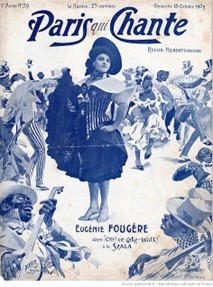The beginning of most human culture is impossible to pinpoint. So it is with the Cake Walk.
The origin of the cake walk dance is likely in the slave quarters of southern American plantations in the early nineteenth century and that is as good a starting point as any.
Group self-entertainment probably included singing songs passed down from the slaves’ African origins. Dancing to this music seems a logical evolution.
Speculation about the style of the cake walk dance, as it is known today, centers on the belief that the dance evolved as a mocking of the parties and social events held by the plantation owners in the “big house.” One popular dance at these events was the European-derived “Grand March,” a couples-parade around the room. Cake walking added exaggerated steps and gestures.
Some stories have it that the slave owners were attracted to the music and the dance, to the point where they became an audience and even awarded prizes to the dancers who they judged the most entertaining. Often the prize was a lavishly decorated cake.

Whatever the truth may be in any of this, in the aftermath of the Civil War travelling minstrel shows added dancing to their repertoire. Vaudeville shows came along with freak shows, animal displays, and the recitation of poetry, and then featured even more elaborate dancing, including prancing steps.
The Philadelphia Centennial Exposition of 1876 brought the dance to a broader public and the dance was picked up by foreign shows.
The French soubrette Eugenie Fougere appeared in the rag-time cake-walk, Hello, Ma Baby which was made in 1899 in the U.S. , where she had been touring. Her appearance on the cover of a 1903 magazine Paris qui Chante dancing to the song “Oh! ce Cake-Walk a la Scala” brought further attention to the dance.

The Library of Congress has a 1903 video of a version of the dance.
The American postcard publisher Franz Huld picked up on
the dance. This card was sent from the U. S. to Groningen in 1900.





couple of French dancers doing the cake walk.

The British publisher Raphael Tuck and Sons published two different versions of this card, which are from the “Carnival” series No. 117 (a set of 12 cards first sold in 1908). They also published the same card as an advertisement for a 1909 San Francisco festival. Both cards are embossed.



The Cake Walk craze, like so many others, literally petered out by the end of the first decade of the twentieth century.




Interesting article Bill. Keep up the good work!
Interesting. I’d never thought about the origin of a cake walk, and hadn’t thought of one at all in many decades! You brought back a memory from the 1960s. In elementary school we had some sort of event, like a field day, and one of the activities was a cake walk, with the winner getting an actual cake. I think it was more like a game of musical chairs.
At the elementary school I attended, a cake walk was a feature of the annual carnival. Music would play as contestants stepped over numbers arranged in a circle. When the music stopped, a number would be drawn from a hat, and whoever was standing on that number picked a dessert from the selection which included plates of cookies and cupcakes in addition to full-sized cakes.
I can visualise the plantation slaves mimicking the society of the slave owners in this way. I have only one cake walk card (from 1904) although I enjoy it.
Hello: I have a Coney Island card with a “Cake Walk” attraction/ride? depicted. Early 1900’s. Divided back.
Thanks for the informative article and interesting images. I actually have the Raphael Tuck and Sons card (plain version) in my collection, never realizing what a history stood behind the “Cake Walk.”